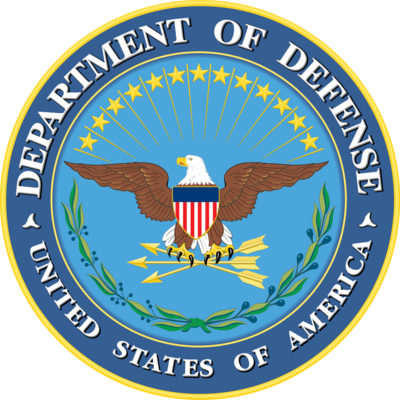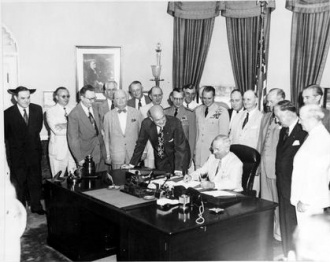Difference between revisions of "US/Department/Defense"
(More subgroups) |
(DoD) |
||
| Line 22: | Line 22: | ||
In a special message to Congress on December 19, 1945, President [[Harry Truman]] proposed creation of a unified department of state defense, citing both wasteful military spending and inter-departmental conflicts. Deliberations in Congress went on for months focusing heavily on the role of the military in society and the threat of granting too much military power to the executive.<ref>{{cite book|author=Hogan, Michael J.|title=A cross of iron: Harry S. Truman and the origins of the national security state, 1945-1954|publisher=Cambridge University Press|year=2000|isbn=978-0-521-79537-1|pages=37–38|url=http://books.google.com/books?id=Hd4C3cY7Y7IC&pg=PA37}}</ref> | In a special message to Congress on December 19, 1945, President [[Harry Truman]] proposed creation of a unified department of state defense, citing both wasteful military spending and inter-departmental conflicts. Deliberations in Congress went on for months focusing heavily on the role of the military in society and the threat of granting too much military power to the executive.<ref>{{cite book|author=Hogan, Michael J.|title=A cross of iron: Harry S. Truman and the origins of the national security state, 1945-1954|publisher=Cambridge University Press|year=2000|isbn=978-0-521-79537-1|pages=37–38|url=http://books.google.com/books?id=Hd4C3cY7Y7IC&pg=PA37}}</ref> | ||
| + | |||
| + | ==9/11== | ||
| + | On June 1, 2001, the DoD changed the rules for military assistance relating to aircraft hijackings, the first time since 1997, to state that for all non-immediate responses, assistance from the DoD must get personal approval from the [[Secretary of Defense]], [[Donald Rumsfeld]].<ref>http://killtown.911review.org/oddities/2001.html</ref> | ||
==Criticism== | ==Criticism== | ||
Revision as of 01:41, 10 November 2015
 | |
| Predecessor | • U.S. Department of War • U.S. Department of the Navy |
| Formation | August 10, 1949 |
| Parent organization | US |
| Headquarters | The Pentagon |
| Type | military |
| Subgroups | • U.S. Department of the Army • U.S. Department of the Navy • U.S. Department of the Air Force • Defense Intelligence Agency • • Defense Information Systems Agency • National Geospatial-Intelligence Agency • • • Defense Logistics Agency • Missile Defense Agency • Defense Threat Reduction Agency • Pentagon Force Protection Agency • National Defense University • National War College • U.S. Special Operations Command • National Guard Bureau • Office of the Secretary of Defense • Joint Staff • Office of the Inspector General |
| The action arm of the Military-industrial-congressional complex, whose functionaries are rewarded in rough proportion to their ability to stifle dissent and channel funds to arms manufacturers. | |
Formerly referred to as the War Department, the "Defense Department" is less interested in defending US citizens than in maximising the control of the deep state forces that sustain it. It cannot be understood in isolation from the Military-industrial-congressional complex spoken about by President Eisenhower.
History

The United States Congress created the War Department in 1789 and the Navy Department in 1798. The secretaries of each of these departments reported directly to the President as cabinet-level advisors.
In a special message to Congress on December 19, 1945, President Harry Truman proposed creation of a unified department of state defense, citing both wasteful military spending and inter-departmental conflicts. Deliberations in Congress went on for months focusing heavily on the role of the military in society and the threat of granting too much military power to the executive.[1]
9/11
On June 1, 2001, the DoD changed the rules for military assistance relating to aircraft hijackings, the first time since 1997, to state that for all non-immediate responses, assistance from the DoD must get personal approval from the Secretary of Defense, Donald Rumsfeld.[2]
Criticism
In 2009, the DoD faced criticism after referring to "protest" as "low-level terrorism".[3]
The DoD has faced criticism about its program of distributing surplus military equipment to US police forces. In 2014, Los Angeles Unified school police officials returned three grenade launchers to the military, although they kept the M-16 rifles and the armored vehicle.[4]
An event carried out
| Event | Location | Description |
|---|---|---|
| REX-84 | US | Scenario and drill developed by the United States federal government to detain large numbers of United States residents deemed to be "national security threats" in the event that the president declared a National Emergency (martial law). |
An example
| Page name | Description |
|---|---|
| DARPA |
References
- ↑ Hogan, Michael J. (2000). A cross of iron: Harry S. Truman and the origins of the national security state, 1945-1954. Cambridge University Press. pp. 37–38. ISBN 978-0-521-79537-1.Page Module:Citation/CS1/styles.css must have content model "Sanitized CSS" for TemplateStyles (current model is "Scribunto").
- ↑ http://killtown.911review.org/oddities/2001.html
- ↑ http://www.foxnews.com/story/0,2933,526972,00.html
- ↑ http://www.latimes.com/local/lanow/la-me-schools-weapons-20140917-story.html